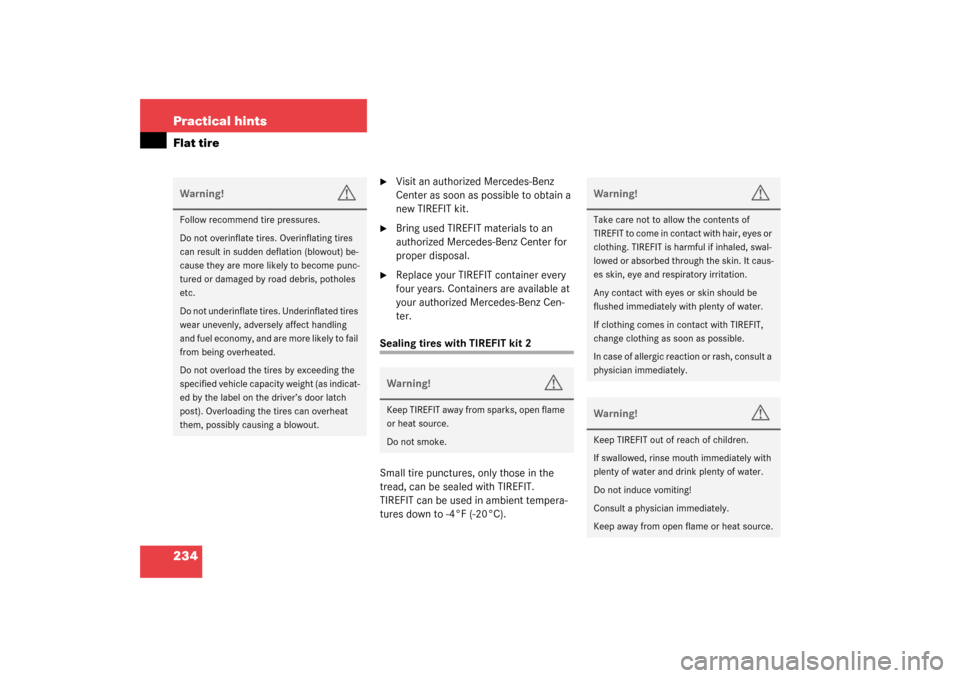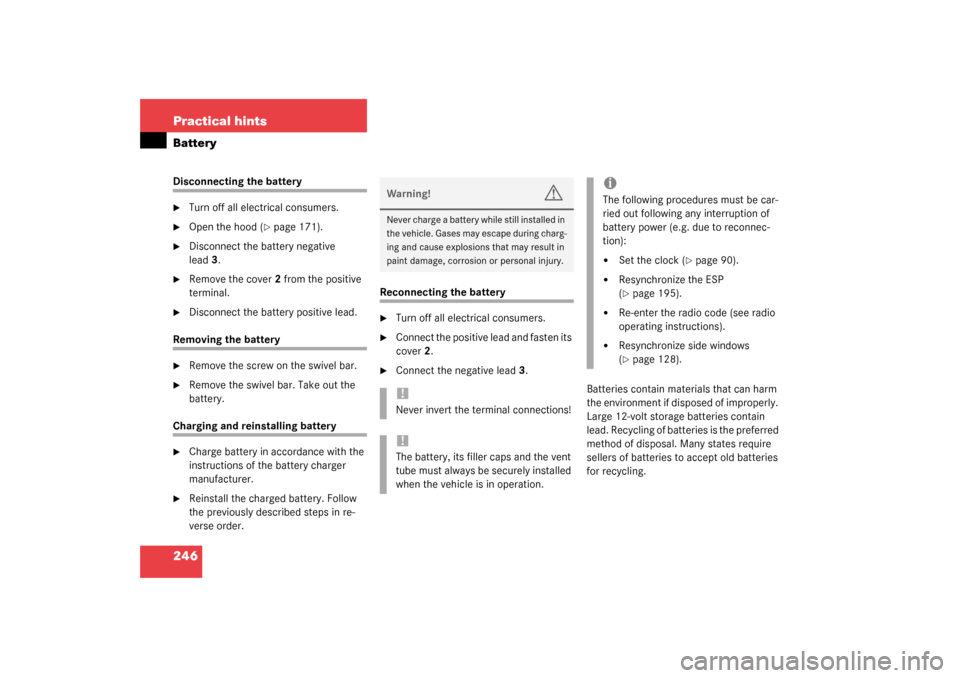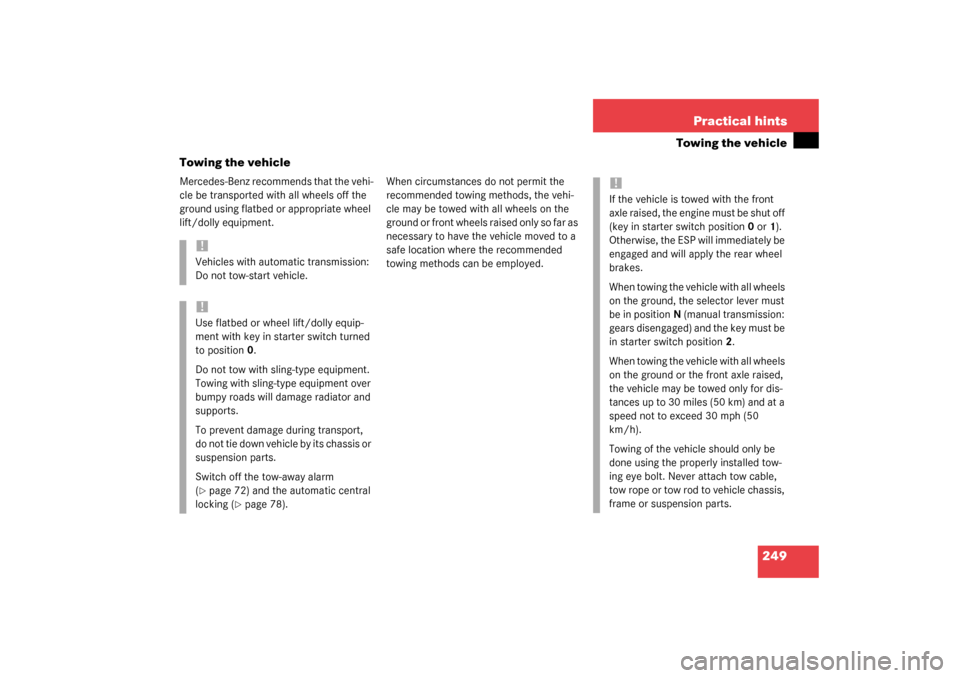Page 195 of 304
195 Practical hints
What to do if …?
Problem
Possible cause
Suggested solution
¿
The yellow BAS/ESP malfunction
indicator lamp comes on while
driving.
The ESP is deactivated because of an inter-
rupted power supply. The ABS may still be
operational.
�
With vehicle stationary and the engine
running, turn the steering wheel com-
pletely to the left and then to the right
to synchronize the ESP.
The BAS has detected a malfunction and
switched off. The brake system is still func-
tioning normally but without the BAS avail-
able.
�
Continue driving with added caution.
�
Have the system checked at an autho-
rized Mercedes-Benz Center as soon
as possible.
Failure to follow these instructions in-
creases the risk of accident.
The charging voltage has fallen below
10 volts and the BAS has switched off.
�
When the voltage is above this value
again, the BAS is operational again.
�
If necessary, have the alternator and
battery checked.
Page 196 of 304
196 Practical hintsWhat to do if …?Problem
Possible cause
Suggested solution
-
The yellow ABS malfunction indi-
cator lamp and warning comes
on while driving.
The ABS has detected a malfunction and has
switched off. The BAS and ESP are also
switched off. Both indicator lamps come on
with the engine running.
The brake system is still functioning normally
but without the ABS available.
�
Continue driving with added caution.
Wheels will lock during hard braking
reducing steering capability.
�
Have the system checked at an autho-
rized Mercedes-Benz Center as soon
as possible.
Failure to follow these instructions in-
creases the risk of an accident.
The charging voltage has fallen below
10 volts and the ABS has switched off.
�
When the voltage is above this value
again, the ABS is operational again.
�
If necessary, have the alternator and
battery checked.
Page 230 of 304
230 Practical hintsFlat tirePreparing TIREFIT�
Take the TIREFIT kit out of the trunk
(�page 208).
1Filler hose
2TIREFIT container
�
Shake contents of TIREFIT container2.
�
Screw hose1 on to TIREFIT
container2.
TIREFIT is now ready for use.
Warning!
G
Take care not to allow the contents of
T I R E F I T t o c o m e i n c o n t a c t w i t h h a i r , e y e s o r
clothing. TIREFIT is harmful if inhaled, swal-
lowed or absorbed through the skin. It caus-
es skin, eye and respiratory irritation.
Any contact with eyes or skin should be
flushed immediately with plenty of water.
If clothing comes in contact with TIREFIT,
change clothing as soon as possible.
In case of allergic reaction or rash, consult a
physician immediately.
Warning!
G
Keep TIREFIT out of reach of children.
If swallowed, rinse mouth immediately with
plenty of water and drink plenty of water.
Do not induce vomiting!
Consult a physician immediately.
Keep away from open flame or heat source.
Page 234 of 304

234 Practical hintsFlat tire
�
Visit an authorized Mercedes-Benz
Center as soon as possible to obtain a
new TIREFIT kit.
�
Bring used TIREFIT materials to an
authorized Mercedes-Benz Center for
proper disposal.
�
Replace your TIREFIT container every
four years. Containers are available at
your authorized Mercedes-Benz Cen-
ter.
Sealing tires with TIREFIT kit 2
Small tire punctures, only those in the
tread, can be sealed with TIREFIT.
TIREFIT can be used in ambient tempera-
tures down to -4°F (-20°C).
Warning!
G
Follow recommend tire pressures.
Do not overinflate tires. Overinflating tires
can result in sudden deflation (blowout) be-
cause they are more likely to become punc-
tured or damaged by road debris, potholes
etc.
Do not underinflate tires. Underinflated tires
wear unevenly, adversely affect handling
and fuel economy, and are more likely to fail
from being overheated.
Do not overload the tires by exceeding the
specified vehicle capacity weight (as indicat-
ed by the label on the driver’s door latch
post). Overloading the tires can overheat
them, possibly causing a blowout.
Warning!
G
Keep TIREFIT away from sparks, open flame
or heat source.
Do not smoke.
Warning!
G
Take care not to allow the contents of
TIREFIT to come in contact with hair, eyes or
clothing. TIREFIT is harmful if inhaled, swal-
lowed or absorbed through the skin. It caus-
es skin, eye and respiratory irritation.
Any contact with eyes or skin should be
flushed immediately with plenty of water.
If clothing comes in contact with TIREFIT,
change clothing as soon as possible.
In case of allergic reaction or rash, consult a
physician immediately.Warning!
G
Keep TIREFIT out of reach of children.
If swallowed, rinse mouth immediately with
plenty of water and drink plenty of water.
Do not induce vomiting!
Consult a physician immediately.
Keep away from open flame or heat source.
Page 246 of 304

246 Practical hintsBatteryDisconnecting the battery�
Turn off all electrical consumers.
�
Open the hood (
�page 171).
�
Disconnect the battery negative
lead3.
�
Remove the cover2 from the positive
terminal.
�
Disconnect the battery positive lead.
Removing the battery�
Remove the screw on the swivel bar.
�
Remove the swivel bar. Take out the
battery.
Charging and reinstalling battery�
Charge battery in accordance with the
instructions of the battery charger
manufacturer.
�
Reinstall the charged battery. Follow
the previously described steps in re-
verse order.
Reconnecting the battery�
Turn off all electrical consumers.
�
Connect the positive lead and fasten its
cover2.
�
Connect the negative lead3.
Batteries contain materials that can harm
the environment if disposed of improperly.
Large 12-volt storage batteries contain
lead. Recycling of batteries is the preferred
method of disposal. Many states require
sellers of batteries to accept old batteries
for recycling.Warning!
G
Never charge a battery while still installed in
the vehicle. Gases may escape during charg-
ing and cause explosions that may result in
paint damage, corrosion or personal injury.!Never invert the terminal connections!!The battery, its filler caps and the vent
tube must always be securely installed
when the vehicle is in operation.
iThe following procedures must be car-
ried out following any interruption of
battery power (e.g. due to reconnec-
tion):�
Set the clock (
�page 90).
�
Resynchronize the ESP
(�page 195).
�
Re-enter the radio code (see radio
operating instructions).
�
Resynchronize side windows
(�page 128).
Page 249 of 304

249 Practical hints
Towing the vehicle
Towing the vehicle
Mercedes-Benz recommends that the vehi-
cle be transported with all wheels off the
ground using flatbed or appropriate wheel
lift/dolly equipment.When circumstances do not permit the
recommended towing methods, the vehi-
cle may be towed with all wheels on the
ground or front wheels raised only so far as
necessary to have the vehicle moved to a
safe location where the recommended
towing methods can be employed.
!Vehicles with automatic transmission:
Do not tow-start vehicle.!Use flatbed or wheel lift/dolly equip-
ment with key in starter switch turned
to position0.
Do not tow with sling-type equipment.
Towing with sling-type equipment over
bumpy roads will damage radiator and
supports.
To prevent damage during transport,
do not tie down vehicle by its chassis or
suspension parts.
Switch off the tow-away alarm
(�page 72) and the automatic central
locking (
�page 78).
!If the vehicle is towed with the front
axle raised, the engine must be shut off
(key in starter switch position0 or1).
Otherwise, the ESP will immediately be
engaged and will apply the rear wheel
brakes.
When towing the vehicle with all wheels
on the ground, the selector lever must
be in positionN (manual transmission:
gears disengaged) and the key must be
in starter switch position2.
When towing the vehicle with all wheels
on the ground or the front axle raised,
the vehicle may be towed only for dis-
tances up to 30 miles (50 km) and at a
speed not to exceed 30 mph (50
km/h).
Towing of the vehicle should only be
done using the properly installed tow-
ing eye bolt. Never attach tow cable,
tow rope or tow rod to vehicle chassis,
frame or suspension parts.
Page 253 of 304
253 Practical hintsFuses
Fuses
A special fuse extractor is supplied with
the vehicle tool kit in the trunk.
Spare fuses are supplied inside the corre-
sponding fuse box.
The fuse chart is printed on the cover of
the corresponding fuse box.
The amperages of the fuses are also given
there.
Main fuse box
The main fuse box is located in the engine
compartment on the left hand side.
The main fuse box contains fuses for
interior consumers.
1Main fuse boxOpening
�
Release clamp (arrow) and lift fuse box
cover1.
�
Remove fuse box cover.
Closing
�
Fit fuse box cover1 back into the rear
clamp.
�
Close fuse box cover until the clamp
engages.
iOnly install fuses that have been tested
and approved by Mercedes-Benz and
that have the specified amperage rat-
ing.
Never attempt to repair or bridge a
blown fuse. Have the cause determined
and remedied by an authorized
Mercedes-Benz Center.
Page 260 of 304

260 Technical dataEngine
EngineModel
SLK 230 Kompressor
(170.449)
1
1The quoted data apply only to the standard vehicle. See an authorized Mercedes-Benz Center for the corresponding data of all special bodies and special equipment.
SLK 320
(170.465)
1
SLK 32 AMG
(170.466)
1
Engine
111
112
112
Mode of operation
4-stroke engine, gasoline injection
4-stroke engine, gasoline
injection
4-stroke engine, gasoline
injection
No. of cylinders
4
6
6
Bore
3.58 in (90.90 mm)
3.54 in (89.90 mm)
3.54 in (89.90 mm)
Stroke
3.48 in (88.40 mm)
3.30 in (84.00 mm)
3.30 in (84.00 mm)
Total piston displacement
140.1 cu.in. (2295 cm
3)
195.2 cu.in. (3199 cm
3)
195.2 cu.in. (3199 cm
3)
Compression ratio
8.8:1
10:1
9:1
Output acc. to SAE J 1349
192 hp / 5500 rpm
(142 kW / 5300 rpm)
215 hp / 5700 rpm
(160 kW / 5700 rpm)
349 hp / 6100 rpm
(260 kW / 6100 rpm)
Maximum torque acc. to
SAE J 1349
200ft.lb/2500rpm
(270 Nm / 2500 rpm)
229ft.lb/3000rpm
(310 Nm / 3000 rpm)
333ft.lb/4400rpm
(450 Nm / 4400 rpm)
Maximum engine speed
5800 rpm
6000 rpm
6200 rpm
Firing order
1-3-4-2
1-4-3-6-2-5
1-4-3-6-2-5
Poly-V-belt
6ft 2in (1875mm) (routingI)
4ft 5in (1355mm) (routingII)
7ft 10in (2390mm)
9ft 6in (2902mm)